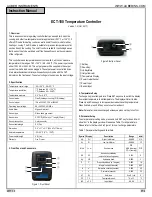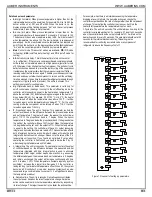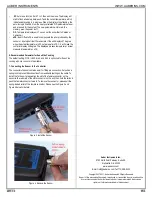
AUBER INSTRUMENTS
WWW.AUBERINS.COM
2017.10
P2/3
Details about each parameter
•
AH
. High limit alarm. When process temperature is higher than AH, the
internal audio buzzer will be energized. For example, if AH set to 290, the
buzzer will be on at 291 and off at 290. When the buzzer is on, the
display window will be flashing between
“
A-H
”
and the current process
temperature. Press Up key to mute the alarm.
•
AL
.
Low limit alarm. When process temperature is lower than AL, the
internal audio buzzer will be energized. For example, if AL is set to 100.
The buzzer will be on when temperature drop to 99. It will be turned off
when temperature rise above 100. The low limit alarm is suppressed at
powering up. It will be reactivated once the temperature has reached set
point. When the buzzer is on, the display window will be flashing between
“
A-L
”
and the current temperature. Press Up key to mute the alarm.
•
Mod
.
Control mode. Three control modes are available:
PID
(PID mode
for heating),
HEA
(on/off mode for heating), and
COL
(on/off mode for
cooling).
•
AS
.
Anti-short cycle delay. This is the delay time to turn on the cooler
(e.g., refrigerator). If the cooler is compressor based, compressor should
not be turned on immediately when it is at high pressure (just after turned
off). Otherwise, it may shorten the life of compressor. The anti-short cycle
delay function can be used to prevent the rapid cycling of the compressor.
It establishes the minimum time that the compressor remains off (after
reaching
cutout) before turns on again. The delay
overrides any controller
demand and does not allow the compressor to turn on until the set delay-
time has elapsed. It gives time to release the refrigerant pressure through
evaporator. It typically set to 6 (minutes). The unit is in minutes. This
setting is only valid for cooling mode.
•
Hy.
Hysteresis band (or dead band). This parameter is valid only for
on/off control mode (heating or cooling). In the on/off heating mode, the
controller will stop sending power to the heater when temperature T is
above the set value (SV), and start sending power again to the heater if T
drops below (SV-Hy). For example, if SV=100 ° C. Hy=3 ° C, the heater
will be turned off when the temperature rises above 100 ° C; it will be
turned on again as the temperature drops below 97 ° C. For the on/off
cooling mode, the compressor will be turned off when T<SV. It will be
turned on again when T>SV+Hy.
•
P
.
Proportional band. The unit is 1 degree. This parameter controls the
output level based on the difference between the process temperature
and set temperature. The greater P value, the weaker the action (lower
gain). If P=7, the proportional band is 7 degree. When the sensor
temperature is 7 degrees below the proportional band (10 degrees below
the setting), the controller will have 100% output. When the temperature
is 5 degree below the set point, the output is 71%. When the temperature
is equal to the setting, the controller will have 0% output (assuming
integral and derivative functions are turned off). This constant also affects
both integral and derivative action. Smaller P values will make the both
integral and derivative action stronger. Please note the value of the P is
temperature unit sensitive. If you found an optimized P value when
operating the controller in Fahrenheit, you need to divide the P by 1.8
when changing the temperature unit to Celsius.
•
I
.
Integral time. The unit is in seconds. This parameter controls the output
of controller based on the difference between the measured and set
temperature integrated with time. Integral action is used to eliminate
temperature offset. Larger number means slower action. e. g. assuming
the difference between the measured and set temperature is 2 degrees
and remain unchanged, the output will increase continuously with time
until it reaches 100%. When temperature fluctuate regularly (system
oscillating), increase the integral time. Decrease it if the controller is
taking too long to eliminate the temperature offset. When I=0, the system
becomes a PD controller. For very slow response system such as slow
cooker and large commercial rice cooker, set I = 0 will significantly reduce
the temperature overshoot.
•
d
. Derivative time. The unit is in seconds. Derivative action contributes
the output power based on the rate of temperature change. Derivative
action can be used to minimize the temperature overshoot by responding
its rate of change. The larger the number is, the faster the action will be.
For example, when there is a disturbance causing the temperature
dropping at a very high rate, the derivative action can change the
controller output based on the rate of change rather than the net amount
of change. This will allow the controller to act sooner. It will turn the
heater to full power before the temperature drops too much.
•
t
.
Cycle rate. The unit is in seconds. This unit determines how long for the
controller to calculate each action. For example, if T is set to 20 seconds,
when the controller decides the output should be 10%, it will turn on the
heater 2 second for every 20 seconds. This parameter should set at 20
seconds for the internal mechanical relay. This setting is also
recommended for controlling a solenoid valve or a compressor of
refrigerator to reduce the frequency of on/off.
Push down
for 6s
74
ah
200
SET
SET
SET
^
V
al
20
SET
SET
V
^
mod
P
/
d
SET
SET
^
V
as
6
SET
SET
V
^
hy
3
SET
SET
^
V
p
18
SET
SET
V
^
i
645
SET
SET
^
V
d
40
SET
SET
V
^
t
20
SET
SET
^
V
at
0
SET
SET
V
^
C-f
O
F
SET
SET
^
V
ofs
0
SET
SET
V
^
end
SET
Figure 1. Flow chart of setting up parameters.





















